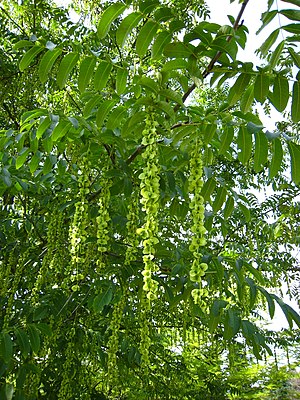Caucasian wingnut
| Caucasian wingnut | ||||||||||||
|---|---|---|---|---|---|---|---|---|---|---|---|---|

Caucasian wingnut ( Pterocarya fraxinifolia ), branch with fruit clusters |
||||||||||||
| Systematics | ||||||||||||
|
||||||||||||
| Scientific name | ||||||||||||
| Pterocarya fraxinifolia | ||||||||||||
| ( Lam. ) Spach |
The Caucasian wingnut ( Pterocarya fraxinifolia ) is a deciduous tree from the genus of the wingnut in the walnut family (Juglandaceae).
description
The tree reaches heights of growth of up to 25 meters. It often grows with many stems; the strong branches are arching. Smaller branches are horizontal, longer ones are slightly overhanging. The broad crown gives the tree a decorative habit. The bark is dull gray and has wide, flat cracks. The branches are green-brown and bare. The alternate leaves are up to 60 cm long and pinnate with about 21 (7 to 27) opposite leaflets, which stand on the bare yellow-green spindle, which has a stalk base about 1 cm thick. The leaflets are close together and partially overlap; they end in a narrow point. The leaflets are glossy green on top and lighter on the underside. The middle leaflets are the longest and reach sizes up to 18 × 5 cm. The autumn color in October is shiny yellow.
The male flowers are thick catkins about 5 to 12 cm long; they appear together with the leaves around the end of April. The kittens are yellowish to greenish and dust around mid-May. The female inflorescences are slender, initially 10 to 15 cm long and covered with about 3 mm small flowers . The inflorescences continue to grow to a length of about 25 to 50 cm. The fruits stand loosely on the basal (i.e. closer to the base) half of the inflorescence and dense on the remaining half. A greenish-white wing sits in a ring on each fruit; so the fruit resembles an elephant's head in frontal view. The wing is about 2 cm wide.
The roots often sprout up to 10 m long runners and thus form a dense bush. In the immediate vicinity of the trunk (about 2 meters) these are so strong that they can even push up pavement and curb stones.
distribution
The Caucasian wingnut is common in the mountain forests from the Caucasus to northern Iran . The tree is found mainly on alluvial surfaces along rivers, where it often forms a thicket with saplings. It requires a moist location, but endures short-term floods.
The tree has also been planted outside of its natural range in parks and large gardens for around 150 years, and in places also used as an avenue tree . It has a particularly decorative effect in autumn thanks to its large golden yellow leaves and fruits.
Location requirements
The Caucasian wingnut can survive in a variety of terrains. It tolerates full sun exposure as well as a shade, a hot to cool microclimate and a dry or wet soil. Their deep roots appreciate nutrient-rich and well-drained soil with a pH value between 5.5 and 8.0 and, if the roots are successful, can even withstand periods of drought.
A sheltered location with a sunny location is the best location. In general, however, the species is resistant to urban climates and deserves the predicate windproof.
use
The Caucasian wingnut provides one of the most valuable veneer woods ( "Caucasian walnut") for the production of furniture . The fine, but very pronounced dark drawing often forms wonderful patterns. So it happens that the tree is sometimes cultivated for forestry in Europe because of its wood.
The unmistakable wing fruits can be used for all kinds of handicrafts.
Toxicity
A poison for fish hunting is obtained from the leaves by rubbing them in water. The leaves contain juglone precursors in the form of glycosides and hydroxyjuglone (1.7-3.0 mg / g dry weight).
literature
- Alan Mitchell: A Field Guide to the Trees of Britain and Northern Europe . Collins Publishers, London 1974 (Eng.)
Individual evidence
- ^ Poison Plants.com . Retrieved October 1, 2013.
- ↑ R. Hegnauer: Chemotaxonomy of plants . Retrieved October 1, 2013.
Web links
- Thomas Meyer: Data sheet with identification key and photos at Flora-de: Flora von Deutschland (old name of the website: Flowers in Swabia )
- About toxicity
- Page with some pictures
- Entry at GRIN Taxonomy for Plants (Engl.)
- Description for Plants for a Future (Engl.)
- Growing instructions for Caucasian wing nuts (Pterocarya fraxinifolia)



